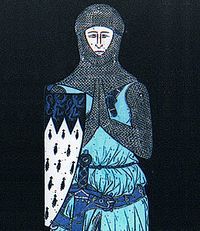|
Title: | Economics and Politics: Warfare in Ewyas Lacy |
|
Before the Normans arrived Ewyas was part of Wales, which was divided into kingdoms that were in constant dispute and war both with each other and with the English across the contested borders. After the Norman conquest the border conflicts intensified as Marcher Lords pushed westwards, and the Welsh kings continued their own battles. A total of 28 Welsh rulers were killed in battle or murdered in the 200 years between 950 and 1150.
The Normans became adept at exploiting internal Welsh enmities to seize large areas of land, which they fortified with their castles. The Welsh became equally adept at retreating into the hills and fighting 'guerilla' style actions. Periodically a strong leader would emerge to unite the Welsh factions and drive the Normans back until he died or was deposed and the Welsh in-fighting recommenced.
This cycle of conquest and rebellion continued until Edward I came to the throne of England in 1272 and determined to crush the Welsh once and for all. By 1282 the whole of Wales was under his rule, and Edward set about constructing the so-called 'Iron Ring' of massive stone castles. These cemented English military domination of Wales for over a century, backed up by harsh government and punitive taxation.
| |
In 1400 Owain Glyndwr, the last great native Prince of Wales, made one final attempt to throw off the English yoke and raised a rebellion against King Henry IV of England. By 1403 Glyndwr had once again united Wales and he set about establishing the country as a sovereign independent state, signing treaties of alliance with France and Spain. The rebellion reached its zenith in 1404, when Owain Glyndwr summoned the first Welsh Parliament who crowned him Prince of Wales. However, by 1408/9 Henry had recaptured the key Welsh castles built by Edward I and regained control of the country, finally putting an end to Welsh ambitions of independent nationhood.
Thereafter the Marcher Lords were broadly able to keep the Welsh under control, until the Marcher lordships were eventually abolished under the Laws in Wales Acts of 1535 -1542, which formally annexed Wales to England. These Acts also established the Council of Wales and the Marches which governed from Ludlow Castle [with a brief hiatus during the English Civil War, which saw considerable fighting in Wales and Herefordshire] until it was in turn abolished in 1689 and Welsh government was transferred directly to London. | |
Follow the links below for references to Warfare in Ewyas Lacy |
| |
| | |
| |




